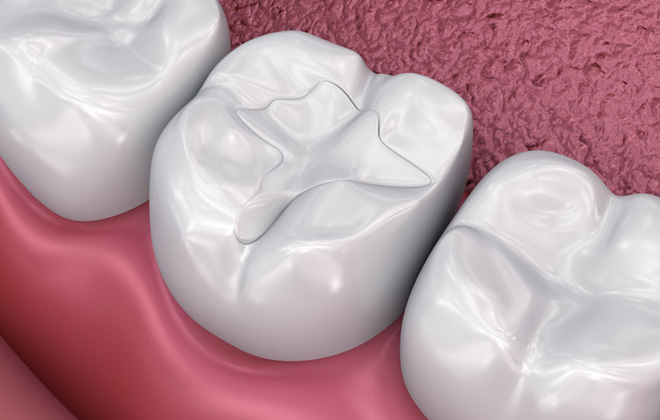Dental fillings are substances that the dentist fill in the tooth when he cleans your decayed tooth and removes debris from it so that the tooth becomes operational again. In addition to fill the space in the tooth, they also help repair cracks in teeth, and teeth which have been worn out by excessive grinding and nail-biting.
Why are dental fillings necessary?
Dental fillings are used make the teeth stronger by artificial materials other than natural teeth. Whenever you have tooth ache, the dentist will try to find the cause and if it turns out that you have dental caries, or tooth decay in your aching tooth, he will proceed with removal of the decay from the tooth after initial examination and uses of anaesthesia if required. Once the decay has been removed, he will clean the debris created by the procedure and clean the area with sanitizer to make sure no bacterial material is left behind. Once the cleaning is done you are left with a hole in the tooth. This hole has to be filled with some material so that the tooth can do its work for which it is created, which is chewing. Chewing exerts lot of pressure on teeth and gums and therefor it has to be strong. To make the tooth strong again the dentist will have to use dental fillings which will work to fill the space in the tooth and make the tooth operable again.
Dental fillings are also used in case of broken or cracked teeth. If you happen to break a tooth in such a way that it has jagged outlines, it hurts the mouth and tongue because of sharp edges. In these cases also the dentist will use a dental filling to make the tooth look normal again and smooth out the outline of the tooth. Similarly, if cracks develop in the tooth due to wear and tear or by accident, the dental fillings are used to fill the crack and make them not so apparent.
Sometimes dental fillings are used when because of whatever reason a big chunk of tooth is broken but the root is safe. In such a case, the dentist will use dental filling to make the tooth whole again so that it can look and work as a normal tooth again. In all these cases, dental fillings can be used as long as the root or the base of the tooth is strong and undamaged, and it stands well in the jawbone.
There are various uses of dental fillings and depending on the cause for which it used, the choice of material of dental filling also varies. The choice of material dental filling also depends on the cost and the individual differences in choices. There is a variety of material for dental fillings to choose from. Your dentist will explain the and help you to choose from the selection that is available in the market.
Materials available for dental fillings
The choice is diverse, including gold, silver, porcelain, silver amalgam, plastic, glass ionomers and composite resin. Silver amalgam may have a combination of mercury with zinc, tin, or copper.
Gold Fillings:
Gold fillings are one of the most durable and strong fillings which can last for years, without corrosion and can endure pressures of chewing, which some people find pleasing to the eye than other fillings. They are very expensive – may be 10 times the cost of amalgam. It also takes more time getting fixed and if placed next to amalgam fillings may produce galvanic shock because of interaction between metals.
Silver Amalgam Fillings:
Silver fillings are longer lasting than composite fillings by many years, and can withstand chewing pressure very well. They are not expensive compared to composite fillings. They are not tooth coloured and therefore are very obvious, in addition to giving a greyish hue to the neighbouring teeth. They need space to be fitted and may require the tooth to be scraped to accommodate the filling, since they expand and contract with hot and cold food more than other composites, resulting in fractures.
Resin Composites:
These are made according to the colour of the teeth, and blend well with neighbouring teeth therefore hardly noticeable. They are preferred when front teeth are concerned. The metal is well suited for bonding and suits very well for supporting the tooth. This material lends itself to be used not only for filling cavities, but also for chipped broken or worn-out teeth. Composite fillings are less durable than amalgam fillings and may take a little longer to be filled in than amalgam. Sometimes composite materials chip off the tooth depending on where they have been used. They are more expensive than amalgam.
Ceramics:
These are made from porcelain and are strong and lasting. At the same time, they are second most expensive than gold. They nearly match the natural tooth in appearance and scarcely noticeable apart from natural teeth. They are very appealing and can withstand the pressure chewing very well. In addition to be used as fillings, they are very well suited when front teeth need to be repaired for cracks.
Glass ionomers:
These fillings are made from acrylic and a special kind of glass. This material is most often used for young children and when required to fill a space below gumline. Glass ionomers are useful as a filling because they release fluoride which helps teeth from getting bacterial growth and decay. Glass ionomers are not as strong as composite and is prone to getting cracked under chewing pressure. It is not very expensive but the lifespan of glass ionomers is about 5 to 6 years.
When your dentist explains the various qualities of the available dental fillings, you will be required to consider the qualities of each and decide according to your priority. You will need to compare prices, keeping in mind your insurance and dental plan and how much additional cost you can bear. Also, you will have to consider the aesthetic value of each choice and decide on what you like. Your choice also will depend on your medical condition, whether you are on special medication, or a special diet and how the material in the dental fillings may interact with the medicines you are taking at present.




